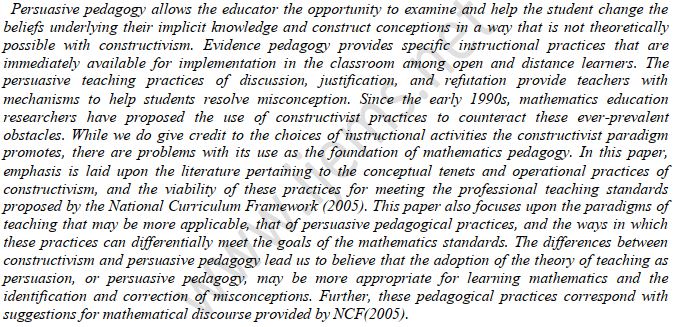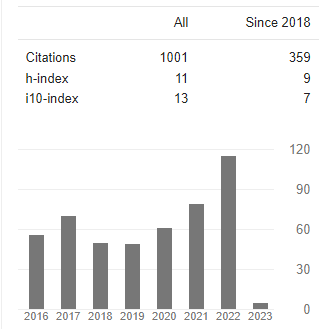INTEGRATING PERSUASIVE PEDAGOGY IN MATHEMATICS LEARNING AMONG OPEN AND DISTANCE LEARNERS: AN ANALYTICAL VIEW
Abstract
Persuasive pedagogy allows the educator the opportunity to examine and help the student change the beliefs underlying their implicit knowledge and construct conceptions in a way that is not theoretically possible with constructivism. Evidence pedagogy provides specific instructional practices that are immediately available for implementation in the classroom among open and distance learners. The persuasive teaching practices of discussion, justification, and refutation provide teachers with mechanisms to help students resolve misconception. Since the early 1990s, mathematics education researchers have proposed the use of constructivist practices to counteract these ever-prevalent obstacles. While we do give credit to the choices of instructional activities the constructivist paradigm promotes, there are problems with its use as the foundation of mathematics pedagogy. In this paper, emphasis is laid upon the literature pertaining to the conceptual tenets and operational practices of constructivism, and the viability of these practices for meeting the professional teaching standards proposed by the National Curriculum Framework (2005). This paper also focuses upon the paradigms of teaching that may be more applicable, that of persuasive pedagogical practices, and the ways in which these practices can differentially meet the goals of the mathematics standards. The differences between constructivism and persuasive pedagogy lead us to believe that the adoption of the theory of teaching as persuasion, or persuasive pedagogy, may be more appropriate for learning mathematics and the identification and correction of misconceptions. Further, these pedagogical practices correspond with suggestions for mathematical discourse provided by NCF(2005).
Downloads
References
Brewer (Eds.), Theoretical issues in reading comprehension (pp. 33–58). Hillsdale:
Lerman, S. (1996). Intersubjectivity in mathematics learning: A challenge to the radical constructivist paradigm? Journal for Research in Mathematics Education, 27, 133–150.
Mason, L. (1998). Sharing cognition to construct scientific knowledge in school context: The role of oral and written discourse. Instructional Science, 26, 359–389.Mathematics Education Monograph, 4, 19–29.
Moschkovich, J. (1999). Students’ use of the x-intercept as an instance of a transitional conception. Educational Studies in Mathematics, 37, 169–197.
Murphy, P. K. (2001). Teaching as persuasion: A new metaphor for a new decade. Theory into Practice, 40, 224–227.
Petty, R. E., & Cacioppo, J. T. (1986). Communication and persuasion: central and peripheral routes to attitude change. New York: Springer.
Piaget, J. (1955). The language and thought of the child (M. Gabain, Trans.). New York, NY: Noonday.
Rumelhart, D. E. (1980). Schemata: The building blocks of cognition. In R. J. Spiro, B. C. Bruce, & W. F.
Von Glasersfeld, E. (1990). An exposition of constructivism: Why some like it radical. Journal for Research in Mathematics Education Monograph, 4, 19–29.















